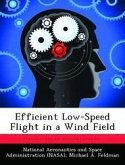In an effort to increase the range of missiles and guided bombs, the USAF is looking at options for new wing configurations. One such configuration being considered is oblique wings. An oblique wing is a wing that pivots about a point on the aircraft fuselage thereby having one side swept forward and the other swept aft. Additional interest is looking at a wing only configuration that also rotates with one wing tip forward of the other. Studies have shown that this configuration can provide less drag for a given lift at both supersonic cruise and subsonic loiter conditions. This experiment focused on the low speed performance of a missile model with an oblique wing. The wing was tested at seven different sweep angles and at two different speeds. In order to simulate the missile dropping from an aircraft the model was inverted over a stationary ground plane in the tunnel and tested at the same wing obliquity angles. Stalling was found at certain conditions including sweep angles of 0, 15, and 30 deg. The ground plane was shown to result in an increase in lift as well as an increase in drag. The ground plane was also shown to add more longitudinal stability, thus making the missile better performing when dropped from an aircraft.
Hinweis: Dieser Artikel kann nur an eine deutsche Lieferadresse ausgeliefert werden.
Hinweis: Dieser Artikel kann nur an eine deutsche Lieferadresse ausgeliefert werden.








